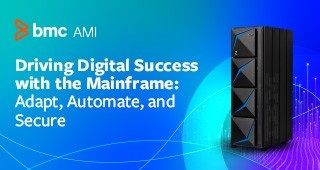In December BMC presented a webinar, in conjunction with IBM Systems Magazine, on Db2 automation. We looked at some of the pressures that are making day-to-day management of Db2 databases so tricky. Whether it’s skyrocketing volumes of data, or continual demands for always-on availability, life has never been so difficult.
It was subtitled “Will You Thrive or Merely Survive?” for reasons that I’ll cover later.
If you missed the webinar, a recording is available here
Will You Thrive or Merely Survive?
Carrying on with procedures that were developed 10 plus years ago is not going to deliver the responsiveness or reduction in costs that you are being challenged to deliver. In fact, if attitudes and procedures are not revised to meet these new demands, it’s unlikely that survival is even an option!
In today’s digital world, with the expectations that your customers have about service levels, you must aim high so that your business thrives.
USBANK
We were happy to welcome Paul Kauza as a guest speaker on the webinar. Paul is a DBA at USBANK, and talked about how automation in general, and NGT in particular, has delivered positive results for USBANK. Paul shared a couple of benchmarks with us – for example, one table they looked at had just over 1 BILLION rows (92GB of compressed data). This took 3.5 hours to reorg with Db2s own on-line reorg, but only 1 hour and 10 minutes with NGT – completing in around 30% of the time (or looked at another way, saved 70% of the original elapsed time),
Intelligent Automation
The way to not only survive but to also thrive is to embrace automation. In the webinar we talked about what “intelligent automation” really means. It goes far beyond simply automating the generation of JCL for later submission. Whilst that does make the DBAs life a lot easier, it does not deliver true automation to the business.
What is needed is to grasp the possibilities provided by Db2s Real Time Statistics and to use those stats to drive automated housekeeping in real-time.
Policies
If you do that, you will also need to define some rules about how the automation is to be carried out. These policies are what give you back control of your current housekeeping strategy that is probably not under your control today – even though it might seem like it is. Automation policies allow not only the definition of when certain tasks should be triggered, but they also allow control over when these actions should (or should not) be undertaken.
This is the power behind the utilities with Next Generation Technology that BMC delivered as part of the v12.1 tools release. NGT provides the policy management to drive true automation as well as enabling high-speed reorganizing of data without causing application outages. NGT also uses the mainframe infrastructure to ensure that the processing is as efficient as possible.
In closing
Again, thanks to everyone who joined the webinar and thanks to Paul for sharing his experiences. Please look out for the next IBM Systems Magazine webinar from BMC Software.







